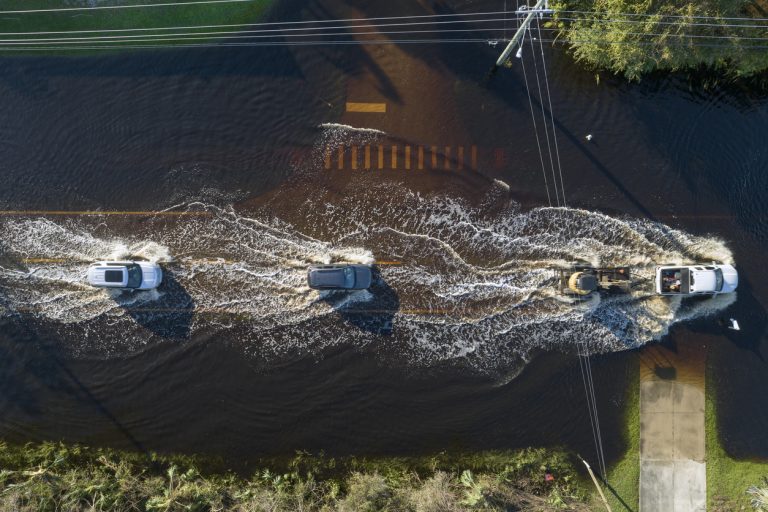Blog Post
When the Skies Change: A New Normal for Fleets and Drivers
By Wheels
July 21, 2025

Hurricane season may officially run from June 1 to November 30, but dangerous weather isn’t confined to the calendar or to coastal storms. As climate change intensifies, we’re seeing more extreme weather events year-round and in many more locations: devastating hurricanes, catastrophic flooding, and widespread wildfires. These natural threats pose serious risks to both drivers and fleet operations. Preparation can be the difference between disruption and disaster.
This year, the National Oceanic and Atmospheric Administration (NOAA) forecasts a 60% chance of an above-normal Atlantic hurricane season, with 3–5 major hurricanes (Category 3 or higher). Meanwhile, flash flooding and wildfire risks are escalating nationwide due to extreme rainfall, drought conditions, and higher temperatures. As NOAA Director Ken Graham warns, “This outlook is a call to action: be prepared.”
Time to panic? No. But is it time for a solid plan? Absolutely. Here’s what fleet managers and drivers need to know to stay safe in any severe weather scenario.
Understanding the threats
Hurricanes are now forming outside of traditional seasons and intensifying faster due to warmer ocean waters. Stronger winds, heavier rain, and larger storm surges increase inland flooding and infrastructure strain. Storms like Hurricane Milton last fall demonstrated how rapidly intensification can leave little time to react.
Flooding is now more frequent and severe across the U.S., as we’ve seen in recent disasters. Warmer air holds more moisture, creating more intense storms. Just 6 inches of water can stall a vehicle, and 12 inches can float most cars. Flash floods can occur with little warning, especially in urban areas with poor drainage.
Wildfires, once a primarily western concern, have become a broader threat across North America. Prolonged drought, rising temperatures, and high winds have caused fires to spread rapidly and often unpredictably, closing major roadways and forcing evacuations with little notice. In addition to the direct danger of flames, smoke significantly reduces visibility and air quality, creating hazardous driving conditions for miles beyond the fire zone. Fleet drivers operating near dry or fire-prone regions must now treat wildfires as a year-round risk rather than a seasonal one.
One rulebook for all weather: driver safety essentials

No matter the type of disaster, there are some universal precautions that can help drivers stay safe, prepared, and responsive in any severe weather scenario.
- Before You Drive
- Stay informed by enabling emergency alerts and monitoring trusted weather sources (NOAA, FEMA, local authorities).
- Inspect your vehicle for road readiness: brakes, tires, windshield wipers, lights, fuel or battery charge.
- Have a driver emergency kit with essentials: water, non-perishable food, flashlight, first-aid supplies, blanket, phone charger, and window breaker.
- Know your route and prepare backup options in case of road closures or detours.
- While Driving
- Slow down and drive defensively, increasing following distance to allow extra reaction time.
- Avoid dangerous conditions like floodwaters, fire zones, high winds, or obstructed roads.
- Use low-beam headlights in poor visibility caused by smoke, heavy rain, fog, or ash.
- Stay connected by checking in with your dispatcher regularly and reporting hazards or delays.
- If Conditions Worsen
- When possible, pull over safely and wait for better conditions if driving becomes hazardous.
- Do not panic — remain calm and follow your safety and evacuation plan.
- Evacuate early if advised, using pre-identified safe routes.
- After the Event
- Avoid hidden dangers like downed wires, unstable roads, or ash pits.
- Inspect your vehicle for damage, water exposure, or signs of impact.
- Report issues or damage to your fleet supervisor immediately.
Fleet manager precautions for the storm, flood or fire

Fleet managers play a critical role in preparing drivers and vehicles for any type of severe weather. These precautions ensure continuity, safety, and clear communication.
- Planning & Preparation
- Monitor weather threats proactively through NOAA, FEMA, and local emergency alerts by region.
- Review risk zones for floods, wildfires, hurricanes, and other hazards, especially in active fleet regions.
- Distribute emergency kits and ensure every fleet vehicle is stocked and weather ready.
- Provide driver training on weather-specific hazards, evacuation protocols, and safe-driving best practices.
- Develop contingency plans, including alternate routes and shelter-in-place options.
- Communication & Coordination
- Establish communication protocols to maintain contact with all drivers during severe weather.
- Use telematics to track vehicle locations and provide real-time route support.
- Send timely updates on route changes, closures, or emergency declarations.
- Fleet Readiness & Logistics
- Conduct seasonal maintenance checks focusing on brakes, tires, electrical systems, and battery life.
- Reassess parking and storage areas to avoid low-lying or fire-prone zones; relocate vehicles preemptively if needed.
- Document post-event inspections and repair needs promptly to minimize downtime.
Stay Proactive, Stay Safe
No matter the forecast, staying informed and having a plan is the most important defense against severe weather. From hurricanes and floods to wildfires and beyond, the nature of extreme weather is changing—becoming faster, more intense, and less predictable. That’s why both drivers and fleet managers must be proactive, not reactive. Monitoring weather alerts, maintaining vehicles, and having clear communication and evacuation protocols in place can save time, protect assets, and most importantly, safeguard lives. Preparation isn’t just a seasonal task—it’s a year-round commitment to safety.
Severe weather isn’t slowing down. Neither should your safety planning.
Wheels continuously monitors weather threats and will notify clients when risks arise. Visit Wheels.com where you can access our Hurricane Hub for ongoing updates, and driver tips to help keep your fleet and drivers safe.
Up Next